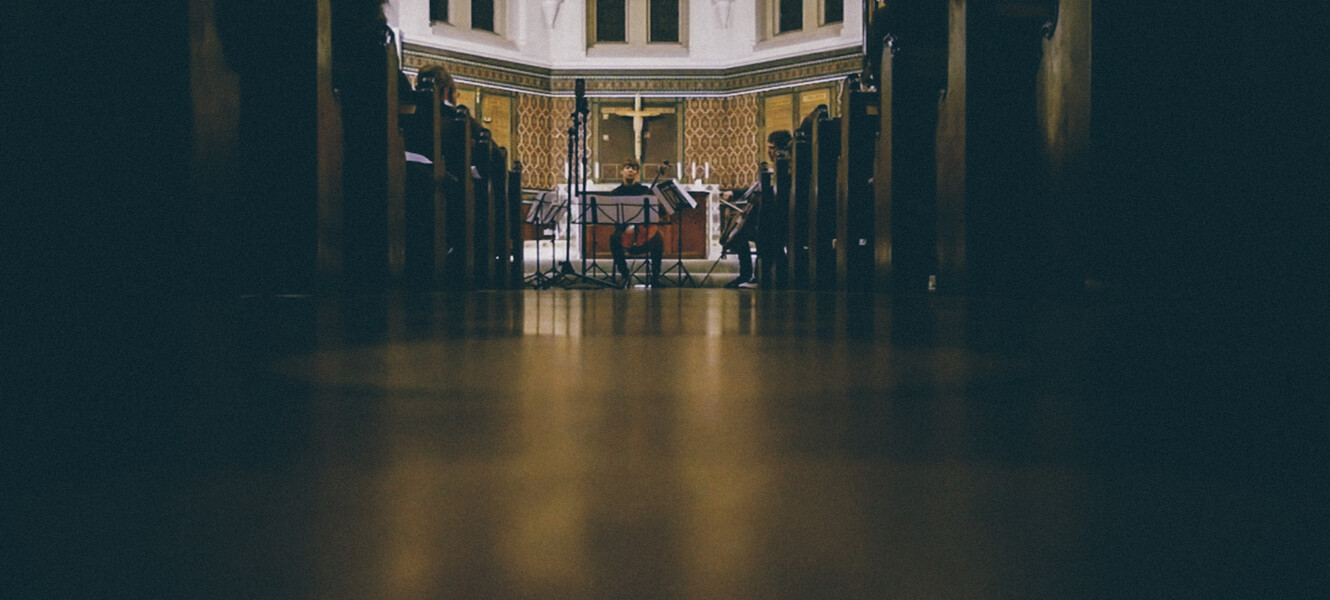
A new playlist of experimental composition compiled for Morley Radio
840 is a London-based concert series dedicated to providing a platform for new experimental and minimal music. Each concert focuses on a particular chamber instrumentation, showcasing a diversity of works by living composers.
This playlist of recordings from the series has been compiled for Morley Radio by curators Alex Nikiporenko and James Luff.
Tracklist:
1. Gregor Forbes – Colour Fields (2017)
In Colour Fields, the performers have three layers of material each – notes and sounds, melodies and chords, and textures – and, depending on time brackets, they can move around between the layers, interacting with one another in pairs or just playing in solitude.
Performed by George Sleightholme (clarinet), Emma Welton (violin) and Alex Wilson (piano) at 840: New Music for Clarinet, Violin and Piano on 25/03/2017 at St James’ Church, Islington.
2. James Luff – Some Music for Molly (2020)
In the course of looking for inspiration (something to steal) in order to begin this piece, I came across a transcription of a short Telemann fantasia. I took the opening chords, transposed them, spread them out, slowed them down, added some notes and then set the three parts moving at slightly different speeds, aiming at something quite static, yet slowly shifting. It is dedicated to my partner Molly.
Performed by Colin Alexander, Stephanie Tress and Peteris Sokolovskis (cellos) at 840: Five Year Anniversary on 31/01/2020 at Café OTO.
3. Scott Mc Laughlin – The Careful Plaiting of Weak Ties (2017)
Two spectral worlds of the bowed string, the harmonic and inharmonic, connected by ‘A’.
“Strength does not come from concentration, purity and unity, but from dissemination, heterogeneity and the careful plaiting of […] ties that are weak by themselves, and that each tie, no matter how strong, is itself woven out of still weaker threads” – Bruno Latour
Performed by The Manon Quartet (Ren Jian, Naomi Watson – violins; Morag Robertson – viola; Deni Teo – cello) at 840: New Music for String Quartet on 06/05/2017 at St James’ Church, Islington.
4. Alex Nikiporenko – Arcs (2014)
“If number existed before music, perhaps before anything, then mathematical concepts are eternal,
and music that comes from numbers is somehow connected with the infinite.” – Tom Johnson
Arcs is a translation of a number row into music. The original row influences everything in the piece, from harmony and rhythm to form and instrumentation. Each movement becomes a crystal- like formation; an object that the audience is invited to appreciate the details of.
Performed by Ruben Zilberstein (violin), Zoé Saubat (cello) and Katherine Tinker (piano) at 840: New Music for Piano Trio on 14/03/2015 at St James’ Church, Islington.
5. Nicholas Peters – HarM (2016)
HarM explores ideas that I first encountered in Kerry Tribe’s double projection of a single 16mm film called H.M. (2009) that was recently on display at The Wellcome Collection, London. Tribe’s film explores the true story of Henry Molaison, an amnesiac man, identified simply as “Patient H.M.”, who underwent “frankly experimental” surgery to cure his debilitating epilepsy in 1953. An unintended outcome of the surgery was that Molaison was unable to form new long term memories although his short term recall, for around 20 seconds, remained intact. I was struck by Tribe’s exploration of this short term recall through the use of a 20 second delay between two adjacent film projections to evoke the duration and loss of memory experienced by Molaison. In my piece I have also set up the same 20 second delay between two adjacent duet performances. Furthermore I have explored two types of material, one whereby the singer is trapped by their inability to create more long term memories and the other whereby the singer re-enacts in sound the scientific mirror drawing experiments Molaison was put through after his surgery.
Performed by Sara Rodrigues (alto), Rodrigo B. Camacho (baritone), Francesca Gilbert (viola) and Peteris Sokolovskis (cello) at 840: Five Year Anniversary on 31/01/2020 at Café OTO.
6. Amber Priestley – feel things way about certainly don’t admire (2015)
In this world obsessed with all things new, I am preoccupied with adaptation. This piece started out as my shortlisted spnm piece and is one of my ways of looking at open-form scores. It has gone through another incarnation for this performance, any 5 performers to any 4.
Performed by BLOCK4 recorder quartet (Emily Bannister, Lucy Carr, Katie Cowling and Rosie Land) at 840: New Music for Recorders on 13/07/2015 at St James’ Church, Islington.
7. Georgia Rodgers – St. Andrew’s Lyddington (2017)
This piece uses the acoustic characteristics of a real space as its basis. The impulse response of St. Andrew’s church was analysed to reveal its room modes—those frequencies which it best supports. The strongest nine frequencies were extracted, along with the corresponding twelve tone equally tempered pitches and deviations in cents. The frequencies are approximated in various ways by the violin and piano, creating an abstracted (or extracted?) version of the sonic space.
St Andrew’s church in Rutland is known for its ‘acoustic jars’ dating from the 15th century which are set into the chancel walls. These features were supposedly meant to help amplify the voice of the priest, but there is some doubt as to whether they would have worked or not.
Performed by Ruben Zilberstein (violin), and Mateusz Rettner (piano) at 840: New Music for Violin and Piano on 16/12/2017 at St James’ Church, Islington.
